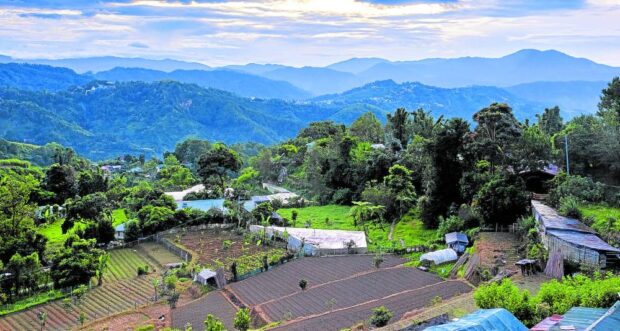
LIVELIHOOD SOURCE The gardens at Barangay Happy Hallow within the Camp John Hay forest reserve, as shown in this photo taken in October 2021, are tilled by descendants of Baguio City’s original settlers. Happy Hallow is the only ancestral domain recognized in Baguio City and is owned by the Ibaloy and Kankana-ey clans. —NEIL CLARK ONGCHANGCO
BAGUIO CITY — The only Ibaloy ancestral domain within the forested section of Camp John Hay here is going to be declared a special heritage zone to ensure its protection and conservation, according to a draft ordinance now being discussed by the city council.
The measure, which passed first reading on Monday at the council’s regular session, would make Barangay Happy Hallow an ecological heritage district.
Happy Hallow is one of the oldest Ibaloy and Kankana-ey settlements in the summer capital. The village has 2,674 residents, who make up 0.73 percent of Baguio’s 366,358 population (as of the 2020 census), many of them urban farmers who grow rice and vegetables.
READ: Ibaloy legacy, domain now part of Baguio cultural map
BCDA’s objections
Spanning 146.4182 hectares, the Ibaloy Domain will be endorsed to the National Historical Commission of the Philippines (NHCP) to be included in its list of National Historical, Heritage and Ecological Sites, according to the proposed ordinance sponsored by Councilor Isabelo Cosalan, who is an Ibaloy.
The council has taken this move even as the certificate of ancestral domain title (CADT) issued to Happy Hallow inhabitants in 2006 by the National Commission on Indigenous Peoples is being challenged by the Bases Conversion and Development Authority (BCDA).
The BCDA, which oversees all former American base lands, including the 600-ha forest reservation of the former John Hay Air Station, has asked the courts to nullify Baguio’s CADT and all other certificates of ancestral land titles (CALTs) within its John Hay jurisdiction. The case is still pending before the Supreme Court.
READ: DENR eyes full land titling in Baguio, Cordillera by 2026
Cultural map
The BCDA had also objected to a farm-to-market road being offered by the Department of Agriculture to give Happy Hallow farmers direct access to local markets, arguing that it may displace portions of the John Hay forest.
But even as the BCDA claim was still being resolved, the city government decided to incorporate into Baguio’s cultural map the history, traditions and artifacts of Happy Hallow, defining them as its “tangible” and “intangible” cultural assets, which the city council approved in February before “Book 1” of the Baguio Cultural Mapping Report was transmitted to the Philippine Registry of Cultural Property.
In 2009, the city council also adopted Happy Hallow’s Ancestral Domain Sustainable Development and Protection Plan (ADSDPP), which serves as a roadmap drawn up by Baguio Ibaloys and Kankana-eys for the domain’s management.
READ: Ibaloy folk brace for change as Baguio flights resume
The ADSDPP, which is required for all CADT in the country, would govern how the Happy Hallow domain would function under the supervision of the city planning and sustainability office (formerly the city planning and development office), with an annual allocation of P5 million, according to the draft ordinance.
Open museum
“The [ADSDPP] represents the direct and collective vision of the indigenous peoples of Happy Hallow to preserve and protect their domain and cultural heritage as one and distinct people,” the measure stated.
READ: Retracing Ibaloy heritage in American-built Baguio
Happy Hallow could serve as an “open museum of living Ibaloy and Kankana-ey culture and traditions where people can learn about the history and [ways] of the original settlers and tillers of the city,” the proposed ordinance said.
Baguio was designed and built from the ground up by the American colonial government in the first years of the 20th century, which pushed many Ibaloy clans to the outskirts.
READ: Baguio execs seek apology to Ibaloys for land loss
“Historical preservation involves much more than simply saving and restoring old buildings and sites of historic importance,” the draft law says, promoting instead the “living heritage approach” as a way to conserve Happy Hallow. The method allows the culture to be perpetuated through continued practice.
READ: Keeping Ibaloy history and heritage alive

